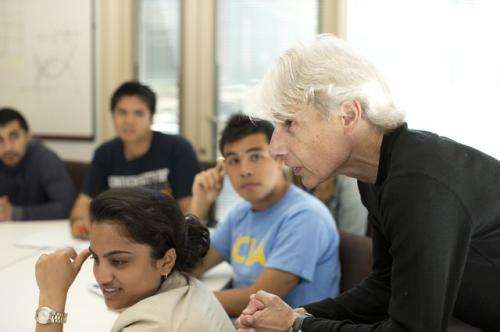Professors' emphasis on student-centered teaching methods hits 25-year high

Online teaching has generated plenty of discussion in higher education, but it's still used by a relatively small percentage of professors. A UCLA study has identified a more pronounced trend in teaching at colleges and universities lately: a greater move toward student-focused teaching practices such as class discussions and group learning, and a corresponding move away from lectures and other teacher-centered styles.
"The Undergraduate Teaching Faculty: The 2013–2014 HERI Faculty Survey," produced by the Cooperative Institutional Research Program, highlights findings from a triennial national survey of college and university faculty by the Higher Education Research Institute at UCLA's Graduate School of Education and Information Studies.
"Although many higher education leaders have placed greater emphasis on creating more online courses to expand access, provide flexibility in teaching, and increase revenue, faculty have proven to be cautious in deciding to teach courses exclusively online," said Kevin Eagan, director of UCLA's Cooperative Institutional Research Program and the report's lead author.
"Faculty understand the time and planning required to develop and successfully implement an exclusively web-based course. But they seem more focused on integrating more opportunities for class discussions and group learning into their courses."
Online teaching
There was a slight increase in the percentage of full-time undergraduate faculty who taught at least one course exclusively online. In the new survey, 17.4 percent of faculty said they had done so, up from 14 percent in 2010–11, when the question was first asked.
The increases varied by institution type, however, with just 8.5 percent of faculty at private universities having taught a course exclusively online and 27.2 percent of faculty at public four-year colleges having done so.
Although relatively few undergraduate teaching faculty have taught an exclusively online course, many more regularly incorporate technology into their courses. More than one-third (35.6 percent) said they frequently incorporate YouTube or other videos, and nearly half report doing so occasionally. Also, 16.1 percent of faculty respondents frequently incorporated online discussion boards into their courses and 34.1 percent did so occasionally.
Trends in teaching approaches
During the past quarter century, the survey has found a consistent shift in pedagogical styles toward more student-centered methods that promote critical thinking skills. The study's authors say the trend indicates that faculty are diversifying their teaching approaches and attempting to identify new strategies to engage students.
For example, in the latest research, 82.8 percent of faculty reported using class discussions in all or most of their courses, up from 69.6 percent in 1989–90. The proportion of faculty who use student evaluations of each other's work in all or most of their courses increased as well, to 28 percent in 2013–14 from 10 percent in 1989–90; and more teachers incorporating student-selected topics for course content increased to 26.3 percent from 8.5 percent during the same period.
At the same time, the percentage of faculty using lectures in all or most of their courses was just 50.6 percent in the new survey, down from 55.7 percent in 1989–90.
Faculty perceptions
Even as the diversity of college faculty and student bodies has increased, faculty who are women and non-white say they still feel they must work harder than their colleagues to be seen as legitimate scholars. More than one-third of women (34.1 percent) said they felt the need to work harder than their colleagues, compared with just 24.1 percent of men.
That view was also held by:
- 49 percent of Latina women, versus 38.9 percent of Latino men
- 32.5 percent of white women, versus 21 percent of white men
- 53.6 percent of black men, versus 48.4 percent of black men
The survey also found that 45 percent of respondents believe that colleagues at their institutions are unprepared to address diversity-related conflict in their classrooms. The sentiment varied considerably by race and ethnicity. Those who agreed, by race and ethnicity:
- White: 43.3 percent
- Asian: 47 percent
- Black: 57.4 percent
- Latino: 60.9 percent
Results were based on responses from 16,112 full-time undergraduate teaching faculty members at 269 four-year colleges and universities. In addition to Eagan, the report's other authors were Ellen Bara Stolzenberg, Jennifer Berdan Lozano, Melissa Aragon, Maria Ramirez Suchard and Sylvia Hurtado .
More information: A summary of the survey and the full monograph are available from the HERI website: www.heri.ucla.edu/
Provided by University of California, Los Angeles

















